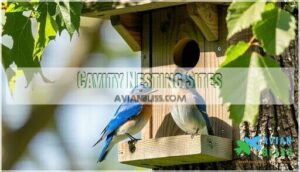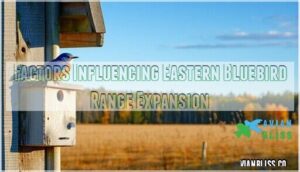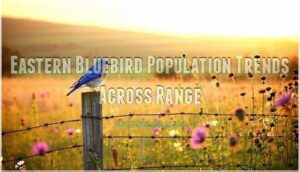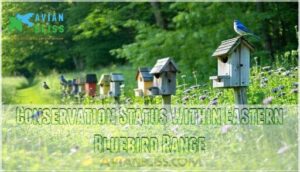This site is supported by our readers. We may earn a commission, at no cost to you, if you purchase through links.
 The eastern bluebird range stretches from southeastern Canada down to the Gulf of Mexico, covering much of eastern and central North America. You’ll spot these birds year-round in the southeastern United States, from Virginia through Florida and west to Texas, where they rarely stray far from home.
The eastern bluebird range stretches from southeastern Canada down to the Gulf of Mexico, covering much of eastern and central North America. You’ll spot these birds year-round in the southeastern United States, from Virginia through Florida and west to Texas, where they rarely stray far from home.
In northern areas, they migrate south as winter approaches, sometimes traveling over 2,000 miles to find milder weather. Open woodlands, meadows, farmlands, and even suburban parks make up their favorite haunts.
Their distribution shifts with the seasons, so spotting them can feel like chasing a moving target—there’s more to their journey than meets the eye.
Table Of Contents
- Eastern Bluebird Range: an Overview
- Habitat Preferences of Eastern Bluebirds
- Eastern Bluebird Range in The United States
- Canadian Distribution of Eastern Bluebirds
- Seasonal Movements Within Eastern Bluebird Range
- Factors Influencing Eastern Bluebird Range Expansion
- Eastern Bluebird Population Trends Across Range
- Conservation Status Within Eastern Bluebird Range
- Range Overlap With Other Bluebird Species
- Future Projections for Eastern Bluebird Range
- Frequently Asked Questions (FAQs)
- Where do Eastern Bluebirds go in the winter?
- What is the difference between a bluebird and Eastern bluebird?
- How rare are Eastern Bluebirds?
- What direction should an eastern bluebird house face?
- Do eastern bluebirds migrate in winter?
- What do eastern bluebirds eat?
- What do their nests look like?
- What do baby bluebirds eat?
- How many eggs do they lay?
- How do Eastern Bluebirds choose nesting territories?
- Conclusion
Eastern Bluebird Range: an Overview
You’ll find Eastern Bluebirds across a vast range that stretches from southeastern Canada to the Gulf of Mexico, with some populations staying put year-round while others migrate thousands of miles.
Their distribution patterns change dramatically with the seasons, creating a complex map of breeding territories, wintering grounds, and migration corridors that spans most of North America.
Year-Round Distribution
Where exactly can you spot Eastern Bluebirds year-round? Resident populations thrive across the southeastern United States, from Virginia to Florida and west to Texas.
These Eastern Bluebird communities enjoy stable climatic influences and consistent resource availability. Their strong habitat fidelity means they rarely wander far from home territories, contributing to impressive survival rates within their permanent distribution range.
Breeding Season Range
During breeding season, Eastern Bluebirds establish territories across their northern range from April through August. Nest Site Selection becomes vital as pairs scout suitable cavities in open woodlands and meadows.
- Clutch Size Variation: Females typically lay 3-7 pale blue eggs per brood
- Breeding Success Factors: Territory quality and food availability determine reproductive outcomes
- Fledgling Dispersal: Young birds leave nests after 16-21 days of development
- Brood Parasitism: Rarely affects Eastern Bluebird nests compared to other cavity nesters
Winter Range
When winter arrives, you’ll discover Eastern Bluebirds in their southern refugia across the southeastern United States and parts of Mexico. These nonbreeding range areas provide essential winter habitat with abundant food availability and suitable roosting sites.
Winter range boundaries extend from the Gulf States to northeastern Mexico, where climate impacts are less severe than northern breeding territories.
Migration Patterns
Eastern Bluebirds demonstrate remarkable migratory patterns that vary dramatically across their range. These migration triggers include temperature drops and food scarcity, prompting different responses based on genetic factors and geographic location.
Migration patterns include:
- Distance variation – Some travel 2,000+ miles while others migrate just hundreds of miles
- Climate influence – Northern populations are entirely migratory, southern birds may stay year-round
- Stopover ecology – Birds use specific rest areas during September-November journeys
- Range map differences – Eastern populations follow distinct routes compared to western edge birds
- Migratory timing – Peak movement occurs during fall months with spring return migrations
Habitat Preferences of Eastern Bluebirds
Understanding where Eastern Bluebirds choose to live helps you spot them in the wild and create better habitat in your own yard. These birds prefer specific environments that provide both hunting grounds for insects and safe places to raise their young.
Open Woodlands and Meadows
You’ll find Eastern Bluebirds flourishing in open woodlands and meadows throughout Eastern North America during the breeding season. These habitats offer perfect hunting perches on scattered trees, where they’ll catch insects with remarkable precision.
Eastern Bluebirds dart between sunlit branches, hunting insects with effortless grace in lush open woodlands and meadows
Edge effects between forests and grasslands create rich food availability zones that support high nesting success rates despite ongoing habitat fragmentation concerns.
Agricultural Lands and Orchards
Agricultural settings provide Eastern Bluebirds with prime hunting grounds across Eastern North America. You’ll find these adaptable birds thriving where farmland meets forest, creating perfect habitat mosaics. The Breeding Bird Survey consistently documents their presence in diverse agricultural landscapes throughout their Eastern Bluebird range.
These working lands offer essential resources:
- Abundant insect prey – crickets, grasshoppers, and beetles thrive in crop fields and pastures
- Berry availability – hedgerows and field edges provide wild fruits during late summer and fall
- Orchard nesting opportunities in older apple and cherry trees with natural cavities
- Perching sites on fence posts, utility lines, and farm equipment for hunting
However, pesticide exposure and habitat fragmentation pose ongoing challenges. Farmland conservation efforts increasingly recognize Eastern Bluebird distribution patterns, creating wildlife-friendly practices that benefit both agriculture and Eastern Bluebird populations across their range. Utilizing insecticide-free orchard sprays can help mitigate the negative impacts of traditional pesticides.
Suburban Areas and Parks
In suburban areas and parks, Eastern Bluebirds thrive in manicured landscapes with open lawns and scattered trees. Parkland habitats provide ideal hunting grounds where they can spot insects from perches. Suburban corridors connecting green spaces support their breeding and nesting activities.
Proper nest box placement and reduced insecticide impacts through community involvement enhance Eastern Bluebird distribution success.
Cavity Nesting Sites
A bluebird’s Nesting Behavior is all about finding the right cavity. You’ll see them inspecting old woodpecker holes or natural hollows in oak and pine, usually 2-20 feet up.
Nest Box Design matters—choose snug birdhouses with bigger entrances for better Nesting Success. Consider appropriate entrance hole sizes to deter larger birds.
Site Selection and Habitat Availability play into Competition Factors, so protecting those nesting spots helps Eastern Bluebird populations thrive.
Eastern Bluebird Range in The United States
You’ll find Eastern Bluebirds in nearly every state across the country, from the eastern forests to the edge of the Great Plains. Their range stretches from northern breeding grounds to southern wintering areas, with some populations remaining year-round in the Southeast.
Eastern and Central States Distribution
You’ll spot Eastern Bluebirds across the eastern and central US, from Maine’s forests to Florida’s sunny fields. Their breeding range stretches into the Midwest Populations, Appalachian Range, and even touches the Coastal Distribution.
Here’s where you’ll see State-Level Abundance and Urban Habitats shine:
- Northern states: Maine, Michigan, Wisconsin
- Southern states: Florida
- Midwest: Montana, Texas, Colorado, Arizona
Eastern Bluebirds are a Texas breeding bird.
Southern Range Boundaries
If you’re exploring the southern range boundaries of the Eastern Bluebird, you’ll notice their territory stretches right down to the Gulf Coast limits and deep into Florida populations. The Texas distribution marks a stronghold, while Mexico sightings are common in winter. Some even call Bermuda home year-round.
These boundaries define the Winter range of Eastern Bluebird, with southeastern US and Orange Area habitats offering reliable food and shelter during colder months.
Northern Range Limits
As you move north, the Eastern Bluebird range stretches into southeastern Saskatchewan, southern Manitoba, and Southern Ontario during warmer months. When winter hits, the northern boundary pulls back to areas like Minnesota and Michigan. Climate Impact and Habitat Loss spark Migration Triggers, influencing:
- Breeding Success
- Winter Survival
- Latitudinal shifts
- Geographic Distribution Shifts
- Changing northern boundary due to climate change
Western Range Expansion
After looking at northern range limits, you’ll notice the Plains westward limit marks a shift in Eastern Bluebird range. Rocky Mountain sightings are more common now, thanks to habitat changes like fire suppression and tree planting.
These Geographic Distribution Shifts bring resource competition, hybridization potential, and climate adaptability, all shaping new range boundaries as climate change effects continue to influence expansion.
Canadian Distribution of Eastern Bluebirds
You’ll find Eastern Bluebirds in several parts of Canada, mainly in southern Ontario, Quebec, and the prairie provinces. Their northern range limit is shaped by climate and habitat, so you won’t see them much farther north.
Southern Ontario and Quebec
If you’re hoping to spot an Eastern Bluebird in Canada, Southern Ontario and Quebec are your best bets. Ontario’s breeding grounds stretch from the north shores of Lake Ontario and Lake Erie, with birds favoring orchards, open pastures, and even burn zones. Quebec’s bluebird territories are mainly in the south, where open habitat and orchards offer ideal nesting sites.
Thanks to Conservation Initiatives like nest box trails and milder winters, the population here has rebounded since the 1970s, with breeding season numbers climbing steadily. The formation of the North American Bluebird Society substantially contributed to this increase. Still, Habitat Loss and Nesting Competition from invasive species keep these birds on their toes.
Migration Routes lead most Ontario birds south for winter, though some tough out the cold. Check a Range Map for hotspots—these colorful harbingers of spring are thriving, but climate impact remains a concern.
Maritime Provinces
If you’re exploring Eastern Bluebird sightings in the Maritime Provinces, you’ll notice their range map highlights New Brunswick, Prince Edward Island, and southern Nova Scotia. These birds favor open rural habitats, thriving where Island Ecology and Coastal Habitats offer plenty of insects and berries.
Here’s what you should know:
- Eastern Bluebirds start nesting early in spring, sometimes reusing last year’s nest, making their breeding grounds productive.
- You’ll find nest box trails across breeding territories, but competition from House Sparrows and Starlings means Sparrow-resistant boxes matter.
- Most bluebirds head south for winter, seeking milder climates and food, leaving summer ranges behind.
- Their distribution is strongest along the Canadian Appalachians, with breeding evidence expanding thanks to conservation efforts and reliable habitat. Creating suitable backyard habitat creation helps support their populations.
Prairie Provinces
The western Canadian range reaches its limits in central Saskatchewan and southern Manitoba, marking the species’ northernmost breeding territories. You’ll find the highest concentrations in Manitoba’s agricultural and sandhill wooded areas in the southwest, where extensive bluebird trails since the 1960s have boosted populations.
Saskatchewan habitats support gradual increases since 1970, despite ongoing threats like pesticide use. Manitoba migration patterns show these birds are entirely migratory, vacating the region each winter for warmer southern areas.
Alberta breeding remains limited to the extreme southeast, where grassland conservation efforts support small populations facing climate impacts on their summer range.
Range Limits in Canada
Eastern Bluebird range reaches its northern boundary at Canada’s southern edge, where boreal limits and climate impacts create natural barriers. Their Summer Range of Eastern Bluebird extends through:
- Southern Saskatchewan and Manitoba in Prairie Expansion zones
- Ontario below the Canadian Shield
- Quebec’s agricultural regions
- Maritime provinces with growing populations
- Bermuda as an isolated breeding colony
Habitat loss and harsh winters prevent further northward movement, making conservation needs critical for maintaining current range map distributions throughout their Breeding Season Range.
Seasonal Movements Within Eastern Bluebird Range
You’ll notice Eastern Bluebirds don’t just stay put year-round – they’re constantly on the move based on seasons and food availability. Their migration patterns range from short local flights to impressive 2,000-mile journeys that connect breeding grounds in Canada with warm winter retreats in Mexico.
Spring Migration Routes
When spring arrives, Eastern Bluebirds begin their northward journey from wintering grounds. These Breeding Migration movements show remarkable Route fidelity, with birds returning to familiar territories.
Weather impacts trigger departure timing, while Navigation strategies guide flocks through Stopover ecology sites.
Timing variations reflect local conditions as birds reach their Breeding Season Range and establish Summer Range territories.
Fall Migration Patterns
When autumn arrives, Eastern Bluebirds begin their southward journey. Fall migration typically starts in late September, with peak departures by mid-October from northern breeding areas. Weather impacts like early frosts trigger these timing strategies.
Post-breeding flocks follow river valleys during their migratory patterns. Migration triggers vary – some birds travel hundreds of miles while others make shorter movements within state lines, demonstrating diverse route variations throughout the nonbreeding season.
Some birds will use nesting boxes as roosts to stay warm.
Altitudinal Migrations
Bluebirds don’t just migrate north and south—they also move up and down mountains throughout the year. Elevation Influence drives these Vertical Movements as birds follow Climate Gradients.
During breeding season, you’ll find them in Mountain Habitats up to 2,000 feet. When winter arrives, they descend to warmer valleys where Resource Availability stays higher, ensuring survival.
Resident Populations
While northern birds head south, many Eastern Bluebird populations stay put in their year-round territories. The Southeastern stability creates perfect conditions for limited migration. You’ll find these breeding season champions enjoying climate resilience throughout winter months.
Their breeding success improves when they don’t waste energy traveling. This Bluebird Range stability helps maintain strong populations across southern states.
Factors Influencing Eastern Bluebird Range Expansion
You’ll discover that Eastern Bluebird range expansion isn’t just about the birds themselves—it’s shaped by everything from rising temperatures to your backyard bird house.
Understanding these four key factors helps explain why you might spot bluebirds in places where your grandparents never saw them before.
Climate Change Effects
As temperatures rise, you’ll notice Eastern Bluebirds shifting their summer and winter ranges northward. Climate changes force these birds to spend more energy staying cool, affecting their breeding success.
Range shifts follow warming patterns, with some populations now overwintering farther north than before. However, extreme weather events and habitat loss from climate change still threaten bluebird populations across their traditional range.
Human-Altered Landscapes
Through urban sprawl and agricultural expansion, human activities have dramatically reshaped Eastern Bluebird habitats across their range. While habitat fragmentation from development poses challenges, many human-altered landscapes actually benefit these adaptable birds.
Here’s how different modifications affect Eastern Bluebird populations:
- Agricultural impact – Converting forests to pastures and orchards has expanded suitable habitat over the past 150 years.
- Urban development – Suburbs, golf courses, and parks provide open foraging areas with scattered perching sites.
- Infrastructure benefits – Power line corridors and roadsides create new nesting opportunities in fragmented landscapes.
- Habitat fragmentation – Dead tree removal reduces natural cavities, but nest box programs successfully compensate.
You’ll notice that bluebirds thrive in modified environments where open spaces meet scattered trees. Their summer and winter ranges now include many human-dominated areas. Climate change, combined with these landscape changes, influences their migratory patterns, with some populations becoming year-round residents in previously unsuitable areas. Conservation strategies focus on maintaining this balance between development and habitat needs.
Conservation Efforts
You’ll find that widespread nest box programs have become the backbone of Eastern Bluebird recovery efforts. Private individuals and conservation groups have installed thousands of artificial cavities across North America, directly countering habitat loss mitigation challenges. The North American Bluebird Society, established in 1978, coordinates these efforts through education and volunteer monitoring programs.
Nest box success rates have dramatically improved through targeted invasive species control measures. Specialized box designs help reduce competition from house sparrows and European starlings. The Nature Conservancy’s Migratory Bird Program supports habitat restoration projects that create climate resilience for these species facing climate change pressures.
Citizen science impact extends beyond box installation. Projects like eBird and Audubon’s Climate Watch track migratory patterns of birds, providing essential data about how climate changes affect Eastern Bluebird populations. These collaborative efforts create stepping stones that allow bluebirds to colonize previously unsuitable areas, supporting continued range expansion.
Competitive Interactions With Other Species
While conservation efforts help Eastern Bluebirds thrive, they still face tough competition from other species that can limit their range expansion. Invasive species like house sparrows and European starlings create the biggest headaches for Eastern Bluebirds. These aggressive birds fight hard for nest sites, often kicking bluebirds out of prime cavities during breeding season. Tree swallows also compete with Eastern Bluebirds for nesting spots, especially in northern areas where good cavities are scarce.
Aggressive behavior from competitors doesn’t just steal homes – it can destroy nests and even kill adult birds. This nest site competition forces Eastern Bluebirds into less suitable areas, slowing their natural range growth.
- Invasive species outcompete bluebirds through aggressive takeovers of nest cavities
- Interspecific interactions limit expansion into areas dominated by competing cavity nesters
- Resource partitioning helps bluebirds coexist, but reduces available habitat quality
Eastern Bluebird Population Trends Across Range
You’ll find that Eastern Bluebird populations have experienced dramatic changes over the past century, from near-collapse to remarkable recovery.
Understanding these population trends across their range helps you appreciate both the challenges these birds have faced and the conservation successes that brought them back from the brink.
Historical Population Fluctuations
Throughout the early 20th century, Eastern Bluebird populations crashed nearly 90%. Invasive species, habitat loss, and pesticide use compounded the crisis.
- Early 20th decline reached a catastrophic 90% population loss
- Invasive species impact from European Starlings and House Sparrows
- Habitat loss causes eliminated key breeding season territories
- Nest box recovery programs reversed devastating trends since the 1970s
Current Population Estimates
After decades of steep decline, Eastern Bluebirds have bounced back remarkably. Partners in Flight estimates 23 million breeding Eastern Bluebirds globally today. Canada supports about 260,000 individuals, while Ontario alone hosts 2,474-12,370 breeding pairs.
Eastern Bluebird numbers have soared, with 23 million worldwide and thousands now thriving in Canada
These population census methods reveal encouraging trends, with North American surveys showing 2.4% annual increases since 1966 despite data collection challenges.
| Region | Population Estimate |
|---|---|
| Global Breeding Population | 23 million birds |
| Canada Total | 260,000 individuals |
| Ontario Breeding Pairs | 2,474-12,370 pairs |
Regional Variations in Abundance
You’ll notice Eastern Bluebird abundance varies dramatically across regions. Ontario’s highest densities occur south of the shield, where well-managed nest box trails thrive. Northern populations remain sparser.
Habitat Fragmentation and Urbanization Effects create patchy distributions, while Food Availability and Climate Influence shape local numbers.
Providing nest boxes can substantially aid their conservation. Nesting Competition with invasive species particularly impacts certain areas, making subspecies adaptation vital for survival.
Factors Affecting Population Density
While abundance varies across regions, several key factors shape where you’ll find the highest Eastern Bluebird densities. Weather extremes hit northern populations hardest, with severe winters causing dramatic population crashes. Understanding these influences helps predict where bluebirds thrive year after year.
Several environmental pressures directly impact Eastern Bluebird populations:
- Food Availability – Insects and berry abundance during breeding season determines reproductive success.
- Nesting Competition – Invasive species like House Sparrows and European Starlings compete for cavity sites.
- Predator Abundance – High predation rates reduce survival, especially in fragmented habitats.
- Habitat Quality – Open woodlands with suitable perching sites support higher densities than dense forests.
Disease impact and climate change further stress populations, while diet composition changes affect nestling survival rates throughout their range.
Conservation Status Within Eastern Bluebird Range
You’ll find that Eastern Bluebirds face both challenges and success stories across their range, making their conservation status a mixed bag of concern and hope.
Thanks to dedicated nest box programs and citizen science efforts, these beautiful birds have bounced back from serious population declines in the mid-1900s.
Threats to Habitat
Eastern Bluebirds face mounting challenges that threaten their survival across North America. Habitat Loss from urbanization eliminates the open woodlands they need. Pesticide Use poisons their insects and contaminated Diet. Invasive Species like European Starlings steal nesting cavities. Climate Changes disrupt migration timing and food availability.
| Threat Type | Impact |
|---|---|
| Habitat Loss | Reduces nesting sites by 40% |
| Pesticide Use | Kills insects they depend on |
| Invasive Species | Outcompete for 60% of cavities |
| Climate Impact | Shifts migration patterns |
Nest Box Programs
While habitat threats pose significant challenges, nest box programs have transformed Eastern Bluebird conservation. You’ll find these artificial cavities strategically placed across open meadows and farmlands throughout Sialia sialis range.
Box Placement requires sunny locations with short grass, perfect for their insect-rich Diet during Breeding Season. Box Materials typically feature untreated wood with proper ventilation. For ideal conditions, consider appropriate nest box materials. Predator Guards on poles prevent snake and mammal access.
Volunteers follow strict Monitoring Protocols, checking weekly for Eastern Bluebirds occupancy and removing invasive species. Program Expansion since the 1960s helped populations rebound dramatically. Lake County reported 888 fledglings from 800 boxes in 2024, showing remarkable success.
Protected Areas and Reserves
Protecting Eastern Bluebirds means creating safe havens where Sialia sialis can thrive year-round. Reserve management focuses on maintaining suitable breeding season habitats while addressing climate change impacts through strategic conservation efforts.
Key protected areas supporting Eastern Bluebird populations include:
- National parks like Everglades, where reintroduction programs achieve 57% territory success
- Forest preserves with structured nest box trails and habitat restoration projects
- Conservation easements that safeguard critical nesting sites from development
- Buffer zones around breeding areas that reduce predation and human disturbance
- Connectivity corridors linking fragmented habitats for population movement
These protected spaces use targeted habitat restoration to maintain open woodlands and grasslands that bluebirds prefer. Reserve management includes controlling invasive species competition and establishing connectivity corridors between fragmented areas. Conservation easements protect private lands from development, while buffer zones create safe breeding environments throughout their range.
Citizen Science Monitoring Efforts
Thousands of volunteers across North America participate in structured monitoring networks that track Eastern Bluebirds throughout their year-round range. These citizen scientists collect weekly data on nest box occupancy, eggs, and fledglings during the pre-breeding migratory season and beyond.
With proper volunteer training and technological integration, participants achieve remarkable data accuracy. Their public engagement efforts have documented over 6,800 monitoring events, directly linking to population increases.
This long-term impact demonstrates how everyday people can meaningfully contribute to understanding feeding behavior, incubation period success, and conservation needs.
Range Overlap With Other Bluebird Species
You’ll discover that Eastern Bluebirds share parts of their range with two other bluebird species, creating fascinating zones where these colorful cousins interact.
These overlapping areas provide unique opportunities to observe how different bluebird species compete for resources and sometimes even interbreed.
Western Bluebird Interactions
Where do Eastern and Western Bluebirds actually meet? Range Overlap between these species is surprisingly limited, occurring mainly in central Arizona and western Texas during winter months.
- Range Overlap happens primarily from October through February in narrow zones
- Competition Dynamics remain minimal since breeding territories stay separate
- Habitat Partitioning reduces direct conflict between Sialia sialis and Sialia mexicana
- Hybridization Studies show extremely rare interbreeding in overlap areas
- Conservation Implications suggest other cavity nesters pose greater threats than subspecies competition
You’ll find these Eastern Bluebirds and Western Bluebird interactions don’t substantially impact either population’s stability.
Mountain Bluebird Encounters
When you spot Mountain Bluebirds (Sialia currucoides) in eastern regions, you’re witnessing fascinating habitat overlap between subspecies of bluebirds. These encounters occur mainly from October through February in northwest Texas, eastern Arizona, and western Colorado. Unlike Eastern Bluebirds (Sialia mexicana), Mountain Bluebirds prefer higher elevations and open meadows.
Identification challenges arise during winter flocks when behavioral differences become less obvious. Interspecies interactions remain minimal since breeding territories stay separate. These seasonal encounters create unique conservation implications, as both species compete for similar winter resources in narrow overlap zones, making habitat management essential for supporting both populations.
Hybridization Zones
The genetic mixing between Eastern Bluebirds and their relatives creates fascinating species boundaries that blur in specific regions. Hybridization zones primarily exist where Eastern Bluebirds meet Mountain Bluebirds, especially across the Great Plains and southwestern Canada. These purple area and teal area overlaps occur in less than 1% of breeding pairs, making hybrid encounters rare but scientifically valuable.
Hybrid fitness remains strong, with fertile offspring capable of reproducing with either parent species. This genetic mixing doesn’t threaten species integrity but offers insights into subspecies of bluebirds evolution. Hybrid vigor sometimes appears in these crosses, though most occur in low-density populations where mate choice becomes limited.
Key hybridization characteristics include:
- Most common in Great Plains boundary zones
- Fertile offspring maintain reproductive capacity
- Occurs primarily during low population density periods
- Conservation impact remains minimal on overall populations
- Provides valuable data on subspecies genetic boundaries
These zones serve as natural laboratories for understanding how species maintain distinctiveness while occasionally sharing genetic material across their ranges.
Competitive Exclusion
Competition among bluebird species rarely occurs due to limited range overlap. Eastern Bluebirds face stronger competition from invasive species like House Sparrows and Tree Swallows, which can claim up to 45% of available cavities. The female’s nesting success depends more on habitat degradation than direct bluebird competition.
| Competitor | Impact Level | Resource Affected |
|---|---|---|
| Tree Swallows | High (45% cavity loss) | Nesting sites |
| House Sparrows | Moderate-High | Eggs and territory |
| Other Bluebirds | Low | Seasonal overlap only |
Conservation strategies focus on addressing nesting competition through habitat management rather than managing bluebird-to-bluebird interactions.
Future Projections for Eastern Bluebird Range
You’ll need to understand how climate change and human activities might reshape where Eastern Bluebirds live in the coming decades. Scientists use computer models and conservation data to predict whether these beloved songbirds will expand north, retreat south, or find new suitable habitats as temperatures rise.
Climate Change Models
While Eastern Bluebirds adapt to different habitats across North America, climate change is reshaping their future distribution patterns. Scientists have developed detailed climate models that paint a clear picture of what’s coming for these beloved birds.
Research shows the Eastern Bluebird range is forecast to shift northward by 200-300 km over the next 50 years under moderate emission scenarios. Global temperatures are pushing species toward cooler regions, creating significant challenges during both Prebreeding Migratory Season and Postbreeding Migratory Season movements. Eastern bluebirds often nest in old woodpecker holes.
Climate models reveal three major impacts:
- Range Shifts northward as maximum July temperatures above 32°C correlate with local population declines
- Habitat Loss with a 25% reduction in suitable southeastern habitat predicted by 2075
- Phenological Mismatch as migration timing advances 1.8 days per decade, disrupting food availability
Extreme weather events and increased drought frequency threaten winter habitat in southern regions. However, breeding territory suitability may increase 10-18% in southern Canada by 2050. Conservation planning must address these projected changes, especially in Western North America where eastern limits may expand into Nebraska and Colorado.
Habitat Conservation Scenarios
Looking beyond the climate forecasts, conservation efforts hold the key to securing bluebird populations. Strategic habitat restoration can dramatically boost their numbers across North America.
Research shows that restored grassland and open woodland habitats could allow a 15% population density increase in northern states. Here’s how conservation scenarios are shaping their future:
- Habitat Restoration projects in prairie regions have raised fledgling success rates by 34% through targeted nest box programs.
- Urban Development corridors with conservation easements maintain genetic diversity between fragmented populations.
- Reforestation Efforts balanced with open spaces create ideal edge habitats where bluebirds thrive on insects and berries.
- Pesticide Reduction in agricultural areas protects their primary food sources during the breeding season.
- Climate Resilience strategies focus on landscape connectivity, helping birds adapt as winter ranges shift northward.
Protected area expansion in the northeast could offset urban sprawl by 12%. Conservation easements across agricultural corridors prove especially valuable, as they provide safe migration routes between subpopulations. When you support habitat conservation scenarios, you’re helping guarantee these azure beauties continue brightening Western North America’s landscapes for generations.
Potential Range Shifts
Climate impacts are reshaping where you’ll spot Eastern Bluebirds. Models predict a northward movement into southern Manitoba and farther Ontario as winter temperatures rise. Western North America may see expansion into central Nebraska and eastern Colorado. However, dispersal limitations and habitat availability create challenges for both male and female birds establishing new territories.
| Region | Expected Change | Timeline |
|---|---|---|
| Southern Canada | 200-300 km northward shift | Next 50 years |
| Western Plains | Expansion into Nebraska/Colorado | By 2050 |
| Gulf Coast | Likely contraction due to heat stress | 2075+ |
Species interactions with competitors and genetic adaptation rates will determine success in these new areas. Year-round residents face different pressures than migrating populations during range shifts.
Long-Term Population Viability Assessments
Population Viability Analysis reveals promising news for Eastern Bluebirds. Models predict stable numbers over the next 25 years with proper conservation strategies.
While habitat fragmentation threatens southern populations, genetic diversity remains strong in northern regions with high nest box density.
Climate resilience varies by location—demographic modeling shows year-round residents adapting better than migrants. Young birds exhibit remarkable flexibility, adjusting breeding timing and foraging patterns to changing conditions.
Frequently Asked Questions (FAQs)
Where do Eastern Bluebirds go in the winter?
Imagine a chilly breeze nudging bluebirds southward; you’ll find them wintering in the southeastern U.S. or Mexico.
Some stay put if the weather’s mild, but northern flocks always migrate, chasing warmth and food.
What is the difference between a bluebird and Eastern bluebird?
You might hear "bluebird" used for any bird in the bluebird family, but the Eastern Bluebird is a specific species with a bright blue back and rusty chest, found mostly in eastern North America.
How rare are Eastern Bluebirds?
Don’t worry, Eastern Bluebirds aren’t as rare as you’d think. You’ll spot them in every U.S. state except Hawaii, plus Canada and Mexico.
Their numbers bounced back thanks to nest boxes and habitat conservation efforts.
What direction should an eastern bluebird house face?
Face your eastern bluebird house toward the east or southeast to catch morning sun and avoid harsh afternoon heat. You’ll give the birds warmth, shelter from wind, and a welcoming spot—like rolling out a bluebird welcome mat.
Do eastern bluebirds migrate in winter?
Yes, eastern bluebirds do migrate in winter, especially those living up north. You’ll see them head south to warmer spots like the southeastern U.S. or Mexico, while some southern bluebirds stick around their territories year-round.
What do eastern bluebirds eat?
You know the saying, “you’re what you eat”? Eastern Bluebirds snack mostly on insects like crickets, grasshoppers, and beetles, but they’ll also munch berries.
Both parents feed the chicks, sometimes with help from older siblings.
What do their nests look like?
You’ll find Eastern Bluebird nests tucked inside tree cavities or nest boxes, built mostly from grass, pine needles, and feathers. They’re neat, cup-shaped, and cozy—perfect for holding pale blue eggs and keeping chicks safe.
What do baby bluebirds eat?
Imagine a tiny picnic basket—baby bluebirds get a feast of insects like crickets, grasshoppers, and beetles, plus berries. Both parents, sometimes older siblings, bring food, making sure the nestlings grow strong and healthy.
How many eggs do they lay?
You’ll usually spot Eastern Bluebirds laying 4 to 5 pale blue eggs in a nest, but sometimes the count stretches from 3 to
The female handles incubation, ensuring the eggs develop safely and steadily.
How do Eastern Bluebirds choose nesting territories?
You’ll spot Eastern Bluebirds picking nesting territories with open fields, scattered trees, and nearby water. They want safe spots with plenty of insects and berries, steering clear of crowded areas or places with too many predators.
Conclusion
Imagine spotting an eastern bluebird in a snowy Ontario field, then seeing the same species in a sunny Texas park months later. You’ve just experienced the eastern bluebird range firsthand.
By understanding their habitat, seasonal movements, and population trends, you’ll be better equipped to help conserve these colorful birds. Keep an eye out in open spaces and suburban parks.
The eastern bluebird range is always changing, and your observations can help protect their future.


















